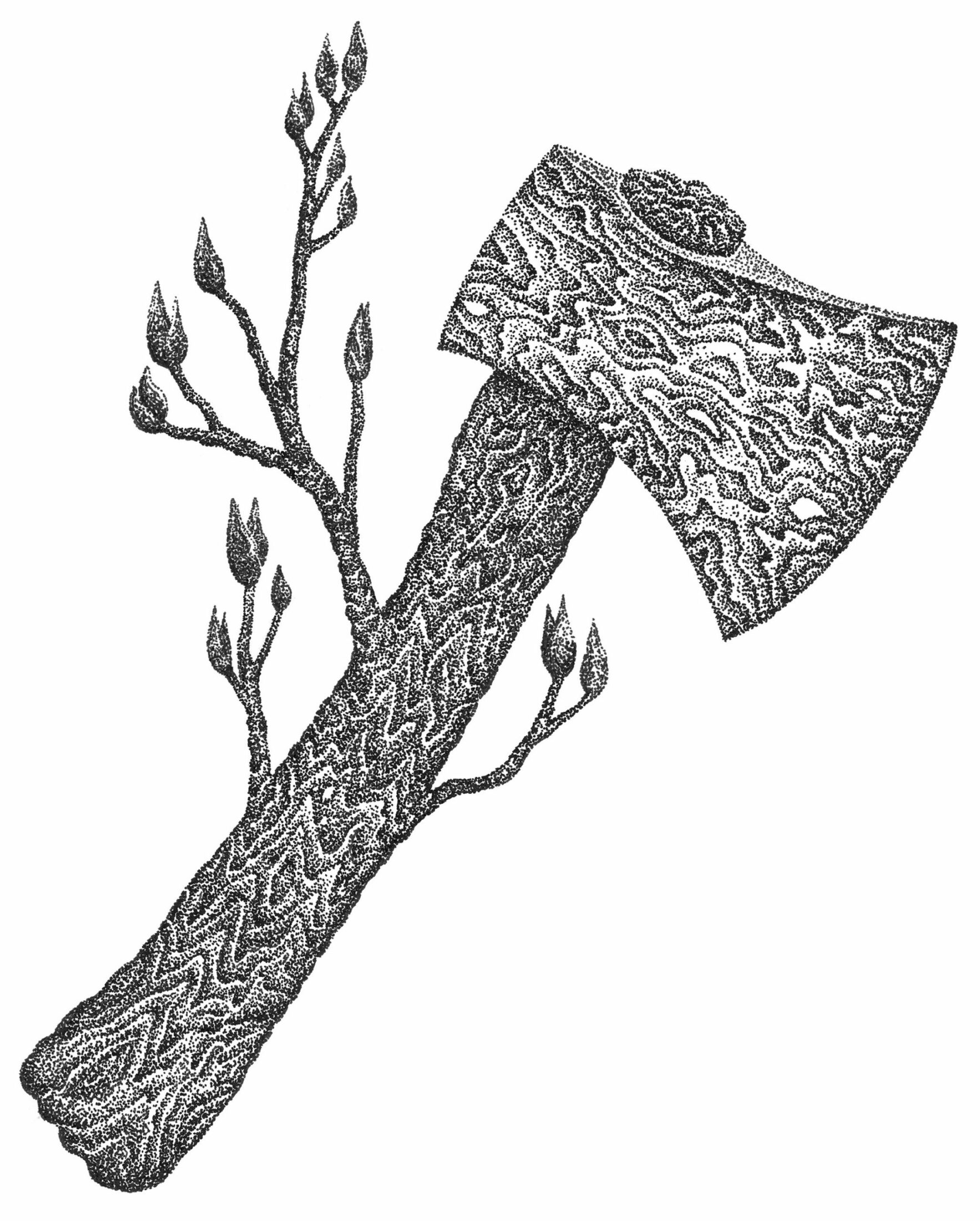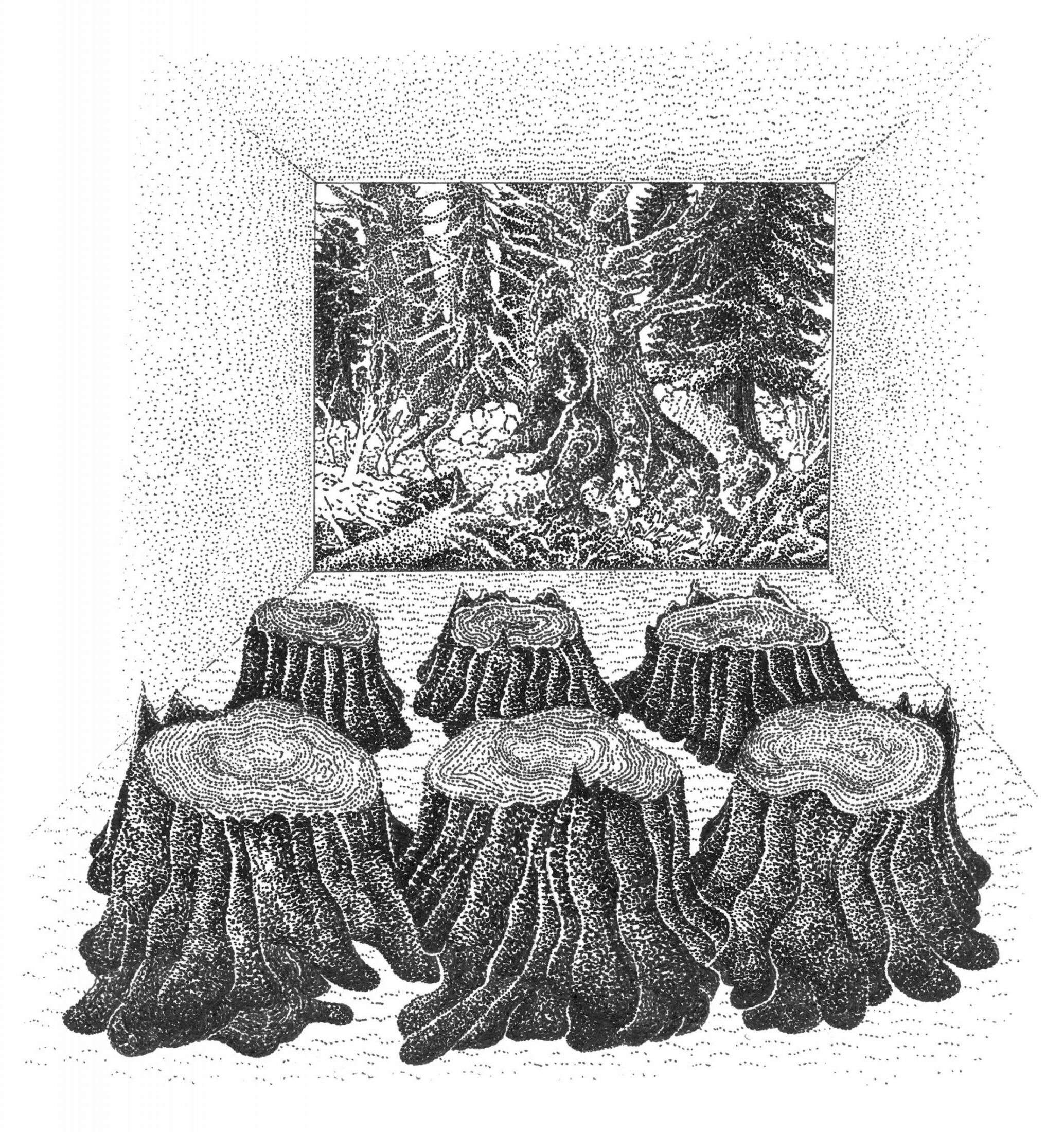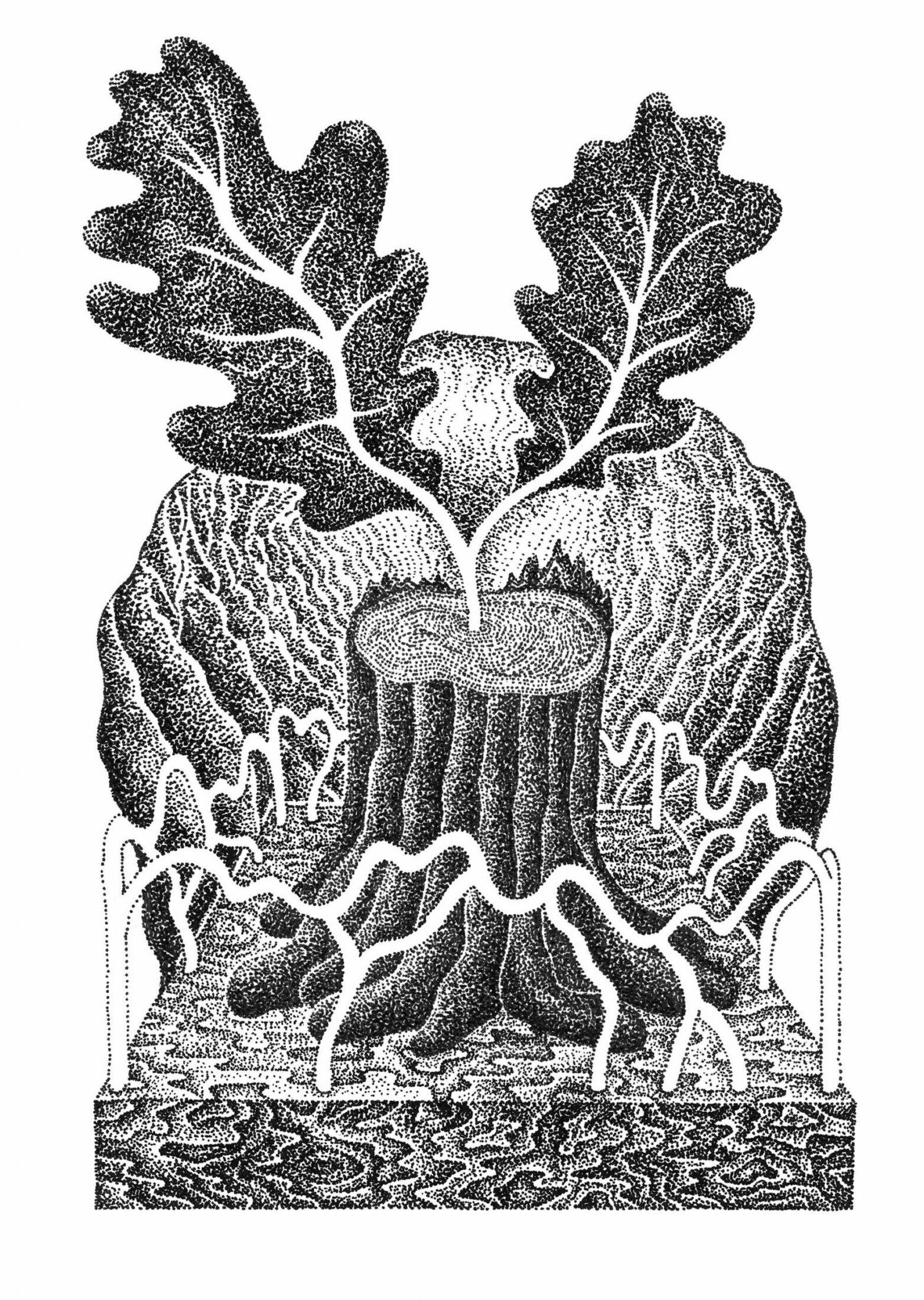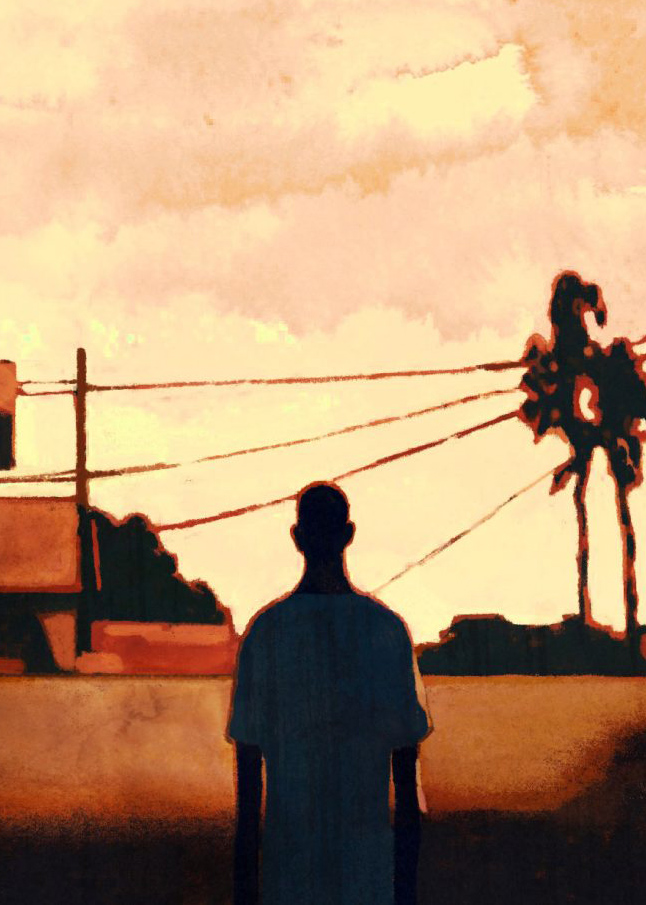
William Bryant Logan is the author of Sprout Lands: Tending the Endless Gift of Trees, Oak: The Frame of Civilization, Air: The Restless Shaper of the World, and Dirt: The Ecstatic Skin of the Earth. He is a certified arborist, serves on the faculty of the New York Botanical Garden, and is the founder and president of Urban Arborists, Inc. William is a contributing editor to House Beautiful, House and Garden, and Garden Design magazines, and is a regular garden writer for The New York Times. He is the recipient of a 2012 Senior Scholar Award from the New York State chapter of the International Society of Arboriculture (ISA), the True Professional of Arboriculture award, and an NEH grant to translate Calderón de la Barca. He has published many translations, including the work of García Lorca, Ramón del Valle Inclán, and Calderón.
Lina Müller is an illustrator based in Central Switzerland. She studied at the Lucerne School of Art and Design, Zurich University of the Arts, and at the Academy of Fine Arts in Kraków. She is the recipient of numerous awards and was nominated for the 2017 Swiss Design Awards.
Luca Schenardi is a Swiss-based illustrator and artist. He studied at the Lucerne School of Art and Design. His illustrations have appeared in international newspapers and magazines, including Süddeutsche Zeitung, Die Zeit, and Rolling Stone Magazine.
After visiting a two-thousand-year-old linden tree in England, William Bryant Logan explores the nearly forgotten practices of coppicing and pollarding, or cutting back a tree to stimulate growth, and discovers a symbiotic relationship between humans and trees.
Each of the four clock faces on London’s Big Ben is twenty-three feet in diameter, each minute hand fourteen feet long. Not one hundred miles away in Gloucestershire is an older, bigger circle that marks a surer, deeper time. It does not need to be wound. A flock of starlings or a heavy snowfall, settling on a minute hand, won’t slow it. It is never down for maintenance. It consists of a ring of living stools from a single linden tree—knots of slender stumps, eight to twelve of them in each stool. I stood in the middle of them, turning slowly around. There were twelve stools, not quite as regularly spaced as the hours on a clock face. They marked time not by hours but by centuries. Every twenty years, the trunks that grew up from these stools had been cut back nearly to the ground, then allowed to grow again.
This living ring is more than three times the diameter of each face of Big Ben. Where I stood at its center had once been the tree’s original solitary trunk. With each cut, the stems sprouted back out from the stump along the margins of the previous trunk, so that over centuries, they made a widening fairy ring that genetically was still a single tree. The year before my visit, more than one hundred long, straight trunks from the stools had been harvested, each about twenty to twenty-five feet tall. The trunks were bound standing together nearby into what looked like the world’s largest sheaf of wheat.
Big Ben is not quite two centuries old, but this tree has turned two thousand. One hundred times, it has had its rising trunks cut back to just above ground level. The tall poles were harvested for building, for charcoal, for firewood, for fiber to make ropes. Again and again. I was flabbergasted when I saw it. How can it be, I thought, that a linden so often cut and manipulated can be among the oldest living things in Britain?
Maybe I should not have been surprised. Trees are functionally immortal. In an ancient redwood, for instance, every year the Methuselah trunk gives rise to hundreds of thousands of brand new babies at the extremities of the twigs. As long as the old one can bring water to the babes and the babes can feed sugar to the aged mass, there is no reason that the tree should die. Trees live simply. They have only three organs—root, stem, and leaf—and only about two dozen possible patterns of growth. They live by repeating this simple module in their chosen pattern, from the scale of a trunk to that of the smallest twig. There is no reason why this reiteration cannot go on forever. Typically, Methuselah breaks or falls, leading to its failure, but even then, the creature may sprout again.
A tree is designed to live a long time, but why should it live longer when people cut it? Most history says the opposite: Once, there were pristine forests, the standard version reads. Then, people began to cut them. As human technologies improved, the woods fared worse and worse. In this view, the destruction began about nine thousand years ago, with the Neolithic stone axe. This tool—laboriously chipped, shaped, and polished—was as different from the Mesolithic axe as a knife from a bludgeon. It was sharp and durable. For the first time, people could harvest branches and, indeed, whole standing stems of trees. With short, sharp chipping strokes, a good axeman could fell a twelve-inch diameter oak in about half an hour. The Proto-Indo-European homonym varna—which meant both the noun “tree” and the verb “to cut”—suggests how important the axe and the wood it could harvest became to cultures around the world. Did the cutting kill the woods?
It did not, because the axe met the sprout. It turned out that when you cut many trees to the base or cut off branches at a height sufficient to keep the sprouts away from browsing herds—processes that in English came to be called coppice and pollard—they simply sprouted again, creating more new trees, more new branches than you had when you started. It may be that the wonderful hazel—whose nut was the staple of Mesolithic Europe and which naturally grew in a multi-stem, repeatedly sprouting form—inspired this learning. If you had eight stems to begin with and you cut four, you would get back all eight, along with three or four new ones.
Thus began around the world a practice not of extraction and imposition but of grateful exchange. Together, people and trees made a new kind of woodland, full of specimens like the ancient Gloucestershire lime tree. The trees that had been cut lived not a shorter but a longer time, often a far longer time. For millions of years, they had lived by repeating their simple three-part module—root, stem, and leaf—by supplying new parts to repair damage done by storms, falling limbs, or pests and pathogens. They were ready and able to respond to cutting. Furthermore, the repeated harvest on a regular cycle of three to twenty years removed older stems that might have had structural problems or potentially lethal infections, allowing the plant to begin afresh.
Not only did a coppice or pollard woodland have longer-lived trees, it was also a better habitat than the uncut forest. Two or three times the number of plant, insect, bird, and mammal species occupied the human-altered woods. At Bradfield Woods in Suffolk, Pete Fordham has managed for three decades a coppice that has only briefly gone out of cycle. While most such woods were lost in the UK before the Second World War, this one persisted because it provided the handles for a rake factory. The business only went belly-up in 1964, so when Fordham and his colleagues started to cut the wood again in 1982, the trees were only a little beyond their normal twelve- to fifteen-year cutting cycle. It was the first time that a cut had been missed in nine hundred years.
When they began to coppice again, a vast seed bank of ancient woodland plants saw the light of day. Hundreds of wildflower and grass species rushed into the newly opened spaces. You do not clear-cut an entire coppice woodland, Fordham explained to me. Rather, you work in stages, a section at a time. In this way, the youngest, newest sprouts stand cheek by jowl with fifteen-year-old veterans. A wide-open meadow with new growing stems adjoins an area where the trees are beginning to limit the light that reaches the ground, and that adjoins another where the canopies have covered the entire space, making an even shade.
A coppiced woodland is divided into sections by a system of ditches and banks: The earth dug out to a depth of three feet or more around the edge of each part is thrown up to make a tall bank on the inside. Each piece is called a coupe, sale, cant, fell, burrow, or hagg and is between half an acre and five acres in size. When first cut, the land looks stone dead, littered with stumps. The very next year and for two or three more, the sunlit dirt blooms. At Queen’s Wood in London, for example, the gardeners counted 39 plant species in a hagg when they coppiced it in 2009. Three years later, the same acre had added 156 more species. Most of them had waited, dormant, for years, since the last cut. Some jumped into the cant from nearby gardens.
In the fourth year, the young poles of the re-sprouting coppice began to shadow the ground. Life changed in their shade. The bramble and raspberry that had sprouted with the sun-loving flowers—first in little spiny fingers, then in sharp feathery branchlets—suddenly covered every bit of open ground. By year’s end, the meadow-like landscape had become a thicket. Not a square inch of ground could be seen. Two more years passed, the poles growing taller and spreading wider, the spiny shrubs rambling over everything beneath them.

By about the seventh year, the spreading tops of the coppice trees closed the canopy. They shaded out both raspberry and bramble; the two disappeared even more quickly than they had come. Under this canopy, the ground opened again, and the shade-dwellers emerged. Some of these, like herb Paris and daffodils, returned, but now they were joined by bluebells, dog’s mercury, wood anemone, ivy, and an occasional insistent bramble.
There were only about seventy plant species in the closed coppice wood, a third of those that had grown in sun. Under the regime of the closed canopy, these plants would grow on until the coppice was felled again.
Like the plants, the birds tended to prefer one or two of the woodland stages. The tree pipit, whitethroat, dunnock, and yellowhammer thrived in early-stage coppice. The thicket stage with its thick ground cover attracted large numbers of nesting birds, including wrens, robins, nightingales, blackbirds, warblers (especially the garden and willow warblers), bullfinches, blackcaps, and chiffchaffs. Tits and robins loved the later pole stage. The nightingale and cuckoo, the most frequently mentioned birds in British poetry, are coppice lovers. The cut woods were not only a resource for fuel and tools, but for the imagination.
There are 27,000 species of insects now in Britain. Half of them depend on human-altered landscapes. About a fifth of these live in deadwood, which, though common in pollard woods, old orchards, and hedgerows, is rare in the fells, the haggs, and panels. Many of the rest thrive in coppice, especially the butterflies. Adults of a species often feed on the nectar of many flowers, but the larvae feed only on one or a small group of species. Without these flowers, the species cannot breed. The Duke of Burgundy, the chequered skipper, and the fritillaries are all declining with the decline of coppice. The fritillaries, for example, depend upon the dog violets, except for the heath fritillary, whose young can only feed on cowwheat. Both plants are found in newly cut coppice panels up to three or four years old. Many of the species cannot disperse across wide areas of the land, so the rhythmic cutting of coppice fells—cyclically renewing their favored habitat—is crucial to their survival.
Coppice and pollard woodlands were far richer in species than uncut woods. Many of these forests depended upon land that was held in common. Members of a community had rights—well regulated by law and custom—to use specific parts of the landscape: to harvest wood or fruit, to dig limestone or iron ore, or to pasture their animals. During the eighteenth and nineteenth centuries in England, most of this common land was expropriated during the enclosure movement, converted into private farm fields. In Spain, however, the effort to take the common land—called desalojamientos, or “throwing them off the places”—did not always succeed. In some places, like the twenty-two square miles of the township of Leitza in Navarra, the commons have never died. (The current law of the commons there runs to twelve legal-size pages.) There, you can see the ancient system, the woodlands at the heart of it still intact. It fed both the belly and the spirit.
The town’s chief monument is not a church or a castle. It is the laundry. The carefully preserved elliptical structure is open to the air above, the walls pierced with large open windows. Inside is a basin punctuated on its raised edge with fifteen smooth, rectangular stone surfaces, each angled into the basin at a pitch that makes scrubbing easy. Beside each is a ledge for the wash bucket. The housewife put the dirtiest clothes—usually the sheets—into the bottom of the bucket, then the more lightly soiled things. On top of the clothes went a filter cloth. Onto the cloth, she poured a few cups of ashes, made from the stems of pollarded beech and ash trees, sprinkling bay leaves on top. She poured hot water into the bucket through the ashes and the leaves. The ash created a slurry of potassium carbonate, while the bay left a pest-repellent perfume. The hot solution soaked for hours, renewed once or twice with more hot water. Then, she released it into the common basin through holes in the bottom of the washtub. The wastewater would be either reused for someone else’s clothes or taken away for other housecleaning tasks. The clean sheets and clothes were set out on the grass of the steep pastures to dry and whiten in the sun.
On the same steep hills, you can find the shepherd’s huts and sheepfolds by looking for pollarded ash trees. Wherever there is a grove of young ash—their new sprouting stems harvested annually to make winter fodder for the animals—you will find nearby the winter quarters of the sheep and the shepherd.
All around the hillsides were much larger pollards, a few of them oaks, but many chestnuts, and most of them beeches. These had gone out of their twenty-year cycle long ago, so their sprouting stems rose into the sky from the short, massive trunks, longer and thicker than the bass pipes of an organ. Had the land been converted to conifer plantations, these pollards would all have been gone, but they persisted on the commons.
Though the large pollards had many uses, a principal one was to feed Leitza’s medieval iron industry. By the thirteenth century, there were sixteen iron foundries in Leitzalarrea, the woodlands of Leitza. To make iron, you needed water, ore, and wood for charcoal, all in close proximity. Each foundry was located on the slopes of the commons to take advantage of this confluence of necessaries. The beech, chestnut, and oak pollards throughout Leitzalarrea yielded the wood, which was converted into charcoal. The ore was heated over the charcoal until the slag separated from the iron, which fell into collecting tubs at the base of the foundry. The waterpower was harnessed with a waterwheel made from the wood of oak pollards and used to drive hammers that shaped the molten mass. From this industry came nails, swords, knives, and axes.
In the Basque lands around Leitza, the axe was a countryman’s main tool. He used it for cutting, hammering, shaping, and even for hoeing. Aizkolaris, the sport of axe cutting, is as popular as soccer there. It is a serious sport. In training, a competitor runs twenty or thirty miles a day, works out with weights, and spends the balance of the day practicing his cutting. He will do this for two or three months, seven days a week, leading up to the contest. Until the 1970s, the Basques were always world champions of this sport.
Brothers Esteban and Patxi agreed to show me how it was done. Both had the stocky build and broad chest that many Basques share. One had thinning gray hair; the other was balding. They were both wearing rugby shirts—one striped green, one orange—with jeans and cross-training shoes. Each man was more than seventy years old, though neither would say just how much more. As younger men, they had been farmers and foresters. Patxi was the axe cutter who had won the world championship almost fifty years before.
They pulled out a beech log from the truck, huffing and smiling. It was about twenty inches in diameter. Then came a box that nested four axes. They stabilized the log by nailing two-by-fours beneath it.
Together, people and trees made a new kind of woodland.
Patxi jumped up on the log, spread his legs wide, and started to cut between them. He cut on the exhale. The huff of his breath and the whizzing of the axe head sounded together. The notch of the kerf was peculiarly made. One side was very steep, almost parallel to the log’s cross section, and the other was at a very wide angle. I noticed that the effect of this shape was to launch the wood that was cut with each blow out of the kerf and onto the ground. That way, he wasted no time clearing the notch. He cut rapidly and steadily, but without hurry. In about a minute, he stopped, handed the axe to Esteban, and they changed places. The brother started the same rhythm. A minute later, Patxi was back in the saddle.
In under three minutes, the log fell neatly in two pieces. Watching this, I understood for the first time how it had been possible to make a world out of such hand tools. A small pollard cut would fall off in two blows. Even the rib of a ship, cut from a curved piece of oak twenty-four inches in diameter, might be reduced to its ship shape in a couple of hours.
Esteban showed me the line of the cuts in the kerf. There was only a pair of little ridges that showed how two cuts were made at slightly different angles. “Those are the mistakes,” he said with a smile. “Those are mine.” The rest looked as though it had been cut with a chain saw, two single, smooth faces that were the result of maybe four hundred blows. This was skilled axe work. The two seventy-plus-year-old men were not even winded.
The commons made a responsive and absorbing way of life. One could choose a life where head, heart, and hand might work in concert. It was not a romantic or nostalgic dream. It was an enterprise like any other, and maybe it was worth the hard work.
How did we lose the way of grateful exchange? If it was so fulfilling, what happened to it? In most places, the enclosures and the Industrial Revolution destroyed it by converting commonly held land into private fields. In the name of efficient, large-scale farming, acre after acre of common land—full of coppiced and pollarded trees—was cleared and converted to row crops or sheep grazing. Modern thinkers actively promoted the change. John Locke himself, in his Second Treatise of Government, had praised the person who enclosed and cleared an acre of land, making it pure farmland, rather than allowing it to continue “lying waste in common.” In the process, smallholders and freeholders, who had used the commons, were converted into laborers, dependent upon their employers for their bread and fuel.
The process accelerated during the eighteenth century in England. In the reign of Queen Anne (1702–1714), only about 1,500 acres were enclosed. Her successor, George I (1714–1727), presided over the seizure of almost 18,000 acres, but that was just the beginning. Under George II (1727–1760), almost 320,000 acres were enclosed, and under George III (the one who lost the American colonies), the total was almost 3,000,000 acres. By the middle of the nineteenth century, the process was more or less complete.

The newly rich made large homes, nested in parks. Majestic, untouched trees were prized, lining the long vistas of these naturalistic forest and meadow confections. In his Epistle to Bathurst, Alexander Pope wrote his justly famous maxim, “Consult the genius of the place in all.” He was counseling lords to remake their landscape into an ideal nature, shifting trees, building hills, installing vales, and sculpting views to imitate an imaginary, untouched landscape. (Real woodlands were, of course, much messier than the designed ones.) They invented the ha-ha, a hidden sunken fence, to keep messy sheep and cattle at a picturesque distance in the unspoiled vistas.
Lord Bathurst’s seat at Cirencester Park is still in a tolerable state of repair, and the beautiful vistas framed by uncut woods are certainly a delight to see. They seemed to represent a rapprochement between man and nature, but in fact they built an impassible, invisible wall, a ha-ha of the mind and heart. In the older woodlands, man and trees were co-actors in nature, of equal dignity and power. They had to respect and respond to each other. In the new picturesque landscape, man became the spectator of an idea of nature that he himself had made in the image of a primordium that had never existed. If you traveled back to the end of the last Ice Age, for example, it is very likely that the wildwood browsed by large herbivores like aurochs much more closely resembled pollard woods than it did our notion of a pristine forest. In fact, there likely never was an untouched forest.
This is not to say that large ancient trees were regarded by the commoner as bad. Every pollard or coppice wood had its “standards,” trees that were grown to maturity, often for hundreds of years, and deeper woodlands remained uncut. But to the new foresters—those who lived during the first time in history when the saw had become cheaper than the axe, and wanted to profit from it—the old ways of exchange were indeed bad ways. John Evelyn, the father of modern forestry, wrote in 1664 that pollarding made “so many scrags and dwarfs of many trees, which would else be good timber.” He called those who did the pollarding “unskillful wood-men and mischievous borderers,” who left trees “a mass of knots, stubs, boils, cankers, and deformed bunches, to their utter destruction.” The often-lopped trees of the commons around villages were thought hideous disfigurements, signs of the backwardness of the stupid, hidebound country bumpkin. The best idea was to burn them or to cut them down and sell them.
The Enlightenment traded a millennial culture of responsive exchange for large farms and pretty pictures. The idea that untouched forests of big trees are always best is therefore not only an aesthetic judgment, but a political pronouncement. It did not, of course, signify that people would no longer harvest wood. With mechanical saws, it was possible to harvest whole trees, slicing them neatly into boards. Indeed, we arborists owe a great deal to the USDA scientist Alex Shigo, who taught us to prune trees so that they grow as clean and straight as possible. The practice gives us beautiful trees, but his employers were interested in the fact that they also gave us the cleanest saw logs.
The culture of grateful exchange, then, became a culture of extraction and imposition. Trees were cut to the ground, their tops and roots discarded in favor of the valuable board feet of lumber. The work could be done more or less responsibly, but in recent decades the trend has been to treat woodlands exactly like immense fields of corn: First, make a plantation. Next, harvest the whole lot. Third, plant seedlings again. Repeat until the land can no longer bear it. Extract the “resource.” Impose a new iteration.
How did we lose the way of grateful exchange? If it was so fulfilling, what happened to it?
Side by side with this industrial exploitation of the woods, however, the picturesque idea of pristine forests thrived. The great national parks of the United States were testaments to the idea of the untouched climax forest. Burning was strictly prohibited, as was any form of harvest. Forest fires were suppressed as quickly as possible.
The result has been a disaster. Scolytid beetles—boring beetles who co-evolved with conifer forests for millions of years—suddenly found themselves with millions of aging, relatively defenseless hosts, trees that before this focus on picturesque landscapes would have been culled by fire. Infesting these, the beetles have been able to destroy large parts of conifer forests in the American and Canadian West, using their unusually high numbers to kill even the younger trees that normally could resist them. Elsewhere, where burning was prohibited, woods built up huge quantities of deadwood, converting ordinary forest fires into conflagrations.
This bicameral view of woodlands—exploit actively on the one hand and preserve fiercely on the other—has led in both cases to less forest health, less biodiversity, and an atmosphere of crisis both in plantation and in parks. Ordinary people are no longer responsible for their relationship to the woodlands around them. In fact, they know almost nothing about them by firsthand experience. Instead, they depend upon cadres of dueling experts to tell them what attitude to have towards this schizophrenic view of trees. The contradiction cannot be resolved. The only commonality between the two is that of the consumer, on the one hand of board feet, and on the other of scenic nature.
In the most unexpected of places, however, the way of grateful exchange is rising again. Uptown, downtown, all around town, in the cities, people are learning to live with trees once more. We do not want our trees for lumber or to look at from a distance—we want them as our companions. They cool the streets, absorb pollutants, sequester carbon, and perform other “ecosystem services.” Indeed, thriving trees are one of the best ways to fight climate change. Beyond that, we simply feel naked without them.
To learn how to create an urban forest, we must turn to models like Bradfield Woods and Leitza. Woodlands of trees of different ages and sizes, some more open and some more closed, are healthiest. The old urban practice of sticking a tree in a postage-stamp-size tree bed is not a good idea. Make your woodland cover a whole space. Fill it with many different plants. Let good plants that are already there remain. Make sure they all have enough dirt and let as many plants as possible share it. Make it long or broad or both, to make passageways for creatures from one place to another. In this way, we can mime the ancient coppice, increasing the diversity not only of plants but also of insects and birds.
The hardest trick is to spread the forest through the rectilinear city grid. Tree pits treat the woods as though each tree were an individual. Rather, trees share with one another. They share soils and mycorrhizae, and they protect one another from winds. When roots graft, a tree in trouble can be nursed by its neighbors. (The grafts can also transmit disease, so vigilance is needed.) One thing to do is to join the planting wells together so they stretch up and down whole blocks. A soil whose surface area is one hundred and fifty by five feet instead of ten by five feet makes much more than a linear gain in health and suitability for a woodland. It gives room for understory planting and for stones. Where people need to cross from the curb to the sidewalk, a stone or Belgian block pathway can make the bridge without interrupting the underground community of the dirt.
A city sidewalk is more like a rock outcrop than a place to grow. The little rectangular opening suggests to the tree that it can thrive there, but when it tries to spread its roots beyond the exposed soils, it runs into a solid wall. In most urban areas, the laws prescribe that the soils beneath a sheet of sidewalk be 99 percent compacted. This way, a firetruck can run over it without collapsing into the muck. Of course, no root can penetrate such a dense, airless, waterless soil. Instead the roots feed on the moisture that typically condenses on the underside of the sidewalk, in the narrow gap between concrete and underlying soil. Growing in that space, they often eventually crack the sidewalk, allowing a shot of both water and air to reach them. Motivated by this success, they keep growing, cracking, lifting the sidewalk, until they have made a way for themselves to live.
The fault is not the tree’s, but ours. If we want an urban forest, we have to make a place for it. One way is to fill the under-sidewalk space with coarse sand, that even when compacted, can still let roots through. Another is to combine coarse gravel, granular soil, and water-holding hydrogels. A third is to create a system of supports that allows the soils beneath the concrete to remain uncompacted. None of these systems works perfectly, but all are in the direction that will allow the woodlands to spread through cities.

We must also relax about what we plant where. Traditionally, street trees have been selected from species that grow in the floodplain: a difficult situation, where one day you may be drowning and the next, bone dry. As we make larger woodlands with more soil area, we will increase the number of species we can successfully use. Many can be natives, but not all.
Soils in cities are often unlike those of the country woodlands. In rural New York State, soils are usually low in pH and moderately low in nutrients. Inside New York City, the dirt is often an amalgam of rubble, macadam, organic garbage, old paint, rubber, and whatever other leavings urban life has deposited there. The pH is high, and nutrients can be off the charts high. In such a soil, a red oak may struggle, but an ailanthus tree will thrive. Why not use a male clone of the tree of heaven—weed tree though it is—in such a situation? Another choice would be a chinkapin oak, not native to New York but well known for its ability to tolerate higher pH.
Frank Lloyd Wright once envisioned and drew a city skyscraper festooned with growing plants on every floor. With green roofs and brilliant, lightweight soil mixes, his vision is beginning to come to fruition. Many city foresters now have a dream of city streets, medians, crossings, and pocket parks, all with woodlands winding down and through them, curling the grid, connecting one to another.
What a crazy, utopian idea!
Years ago, I had the good fortune to attend the memorial service for Jim Henson, creator of the Muppets. One of his writers told the story of the day they all came to him to protest that a given idea that one of them had proposed was simply unworkable, idealistic, and would never fly.
“Maybe you’re right,” Henson answered. “Maybe it can’t work.”
He paused.
“But if it did work, it would be a good thing, wouldn’t it?”
Who will care for this urban forest? The people who live there must. For one thing, they must have a voice in what is planted where, or where they want sun for vegetables and flowers, where shade for a cool seat is desired. For another, they must have a stake in the results. This is not a pipe dream. In New York City, Trees New York has quietly been training citizen pruners for the past half century. After a fine short course, the graduates are given a certificate that allows them to prune any city tree from the ground. If the people in a neighborhood can take on the care for their local trees, the woodlands will benefit, and so will those who do the care. Once again, as in the Neolithic and the Middle Ages, trees and people will live together, helping one another.
In a city like New York, pollarded and coppiced trees find a new place. In front of the Metropolitan Museum of Art, my company was asked to train four small groves of pollards, each a block of ten London plane trees. As they form solid groves, they show how right they are for the space. The designers brilliantly used one of the uncompacted soil systems under each bosque, so the trees have plenty of dirt. Because they are planted in blocks, the planes help one another to grow, both above and below ground. People respond: hundreds sit each day at the tables beneath them in the gentle shade. The trees don’t tower; they enfold. In winter, the branch patterns of the trees, each distinct according to just how the tree was cut, enliven the pavement with their shadows.
There likely never was an untouched forest.
It is not only pleasant. Because the trees stay small, they never develop large branches that may fall and do harm. Because they are annually pruned, the roots beneath retrench, remaining smaller and fibrous, so it will be many years (if ever) before they begin to lift the pavement. The annual pruning makes a dense cover that not only shades museum visitors but also provides protection to birds. The shade is no less definite than it would be were the trees much larger. Pollards might be widely planted in cities to take advantage of these qualities: under wires, on streets, in medians.
Coppiced trees and shrubs also make fine plants for a new urban forest. When cut to the ground, they come back with large and numerous leaves, often growing eight to fifteen feet tall in one year. The new leaves are larger and denser than they otherwise would be. Coppiced paulownias, for example, are deep green and bigger than platters. Variegated catalpas are heart shaped, shot through with lilac or yellow highlights. Smoke bushes grow as a shock of ruffled deep purple. People take pleasure in the sight of them. Birds delight in the close-set, thick leaves that provide cover.
An old-growth forest is a wonderful creature, but so are the symbiotic woods in which trees and people work together. Rising industrial oligarchs once decided that human woods were bad. In place of a culture of grateful exchange, they imposed an economy of extraction and imposition, of command and control. We must take back our living, active, responsive relationship to our woodlands. In the cities, we have already begun.







